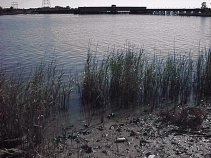|
I use a long handled small
mesh (1/16"?) white net to collect the ghost shrimp.
The handle is about the size of a broom handle. These nets
you will see used at bait houses being used to scoop up live
bait shrimp and fish.
 Areas
such as public boat ramps, parks and picnic areas that are
on water frontage and where there is grass will usually have
ghost shrimp as long as the temperature and water conditions
are within the shrimps tolerable range. This certainly would
include the Gulf Coast states as well as Southern California.
Fresh water species inhabit many lakes, ponds rivers and irrigation
canal systems. I wade around the grass beds and evenly and
smoothly sweep the net in a scooping motion towards the grass
from deep to shallow. It is not necessary to make
a lot of commotion while moving the net ... smooth
movement is sufficient to capture the shrimps as long as the
water is not extremely clear (very clear water is rare in
the Bays near Houston Texas where I live). Areas
such as public boat ramps, parks and picnic areas that are
on water frontage and where there is grass will usually have
ghost shrimp as long as the temperature and water conditions
are within the shrimps tolerable range. This certainly would
include the Gulf Coast states as well as Southern California.
Fresh water species inhabit many lakes, ponds rivers and irrigation
canal systems. I wade around the grass beds and evenly and
smoothly sweep the net in a scooping motion towards the grass
from deep to shallow. It is not necessary to make
a lot of commotion while moving the net ... smooth
movement is sufficient to capture the shrimps as long as the
water is not extremely clear (very clear water is rare in
the Bays near Houston Texas where I live).
The water around the grass is usually a foot or so deep.
There are oysters (and lots of shells in many of these areas)
growing on any rock so you have to avoid those as they are
sharp and will tear your net (and you too if you aren't careful).
I wear rubber boots or old tennis shoes (but definitely something
to protect my feet). When the tide is out I will usually have
good success by raking the net gently across the bottom towards
the grass beds and right up against the grass blades.
These shrimp are very easy to catch. You will also catch
lots of small crabs and small fish (be careful you
do not keep any fish considered game fish as a game warden
would likely fine you several hundred dollars for each illegal
fish). Check the game/fishing laws in your state/area.
In Texas you need only a fishing license and a salt water
stamp to collect 'bait'. The pipefish I catch are on a federal
watch program but as of yet have not been put under any protection.
After catching the ghost shrimp I put them in a plastic 5
gallon bucket with a battery operated air pump and stone (you
can get these where bait and fishing tackle is sold - Academy,
Kmart and Wal-Mart stores here). If its very hot outside I
put the bucket inside the air conditioned cab of my truck
for the ride home. I also put the bucket inside a Rubbermaid
container to contain any splash that may occur in transit.
Once you get your shrimp home a ten gallon tank with air
stone and I use mangroves kept upright by inserting them in
Styrofoam for filtration supplemented with occasional small
whisper power filter as the only filtration. I'll usually
transfer the smaller shrimp (ones of the right size for Seahorses
to munch on) to the tank with the Seahorses. These shrimp
will live a long time in the main tank as long as you feed
them a little flake food every day or so. The larger females
also usually have eggs under their tails which once they are
released into the current make excellent food for Seahorses
and corals alike.
The Specific gravity of the water where these shrimps are
collected varies (as I have measured it) anywhere from 1.014
to 1.026 depending upon rainfall amounts prior to the collection
trip. These shrimp can adjust to a wide range of salinity
in my experience. If you will acclimate them fairly slowly
over a few hours similar to how you would acclimate any salt
water fish. Actually these shrimp can be acclimated pretty
quickly once you get the hang of it. Just do not take them
from 1.014 to 1.026 in 60 seconds unless you want to kill
them prior to freezing them. If you do want to freeze some
remove the heads as the heads will rot fairly quickly.
I enjoy collecting the shrimp and also copepods (or is it
arthropods?) from clumps of grass in the bays. I will sometimes
us a cast net in open sandy bottom areas and have caught small
green eels, puffer fish, stingrays, small sharks, etc. I also
scuba dive, boat and fish. I've always loved the water and
everything in it and around it.
|

